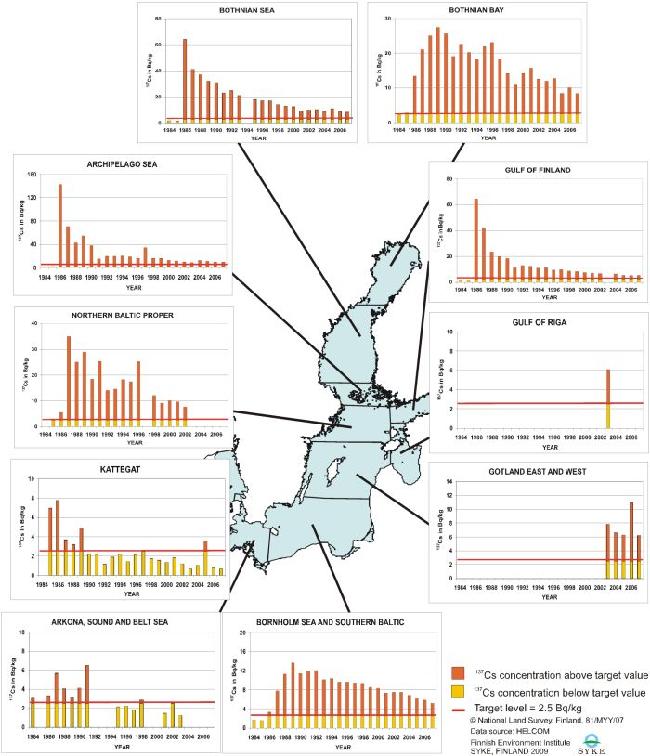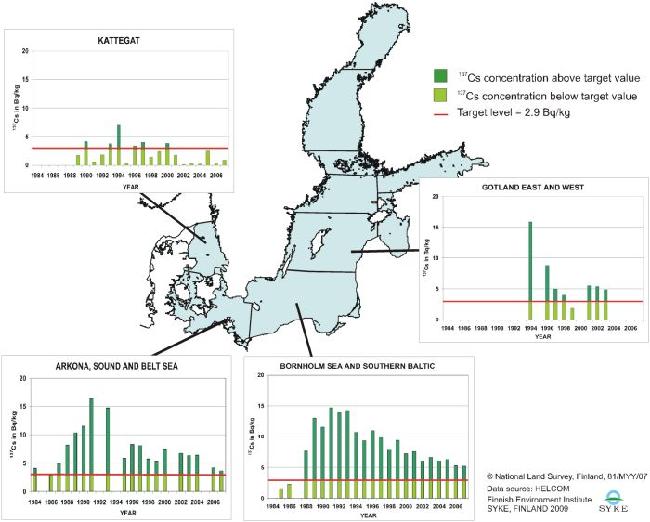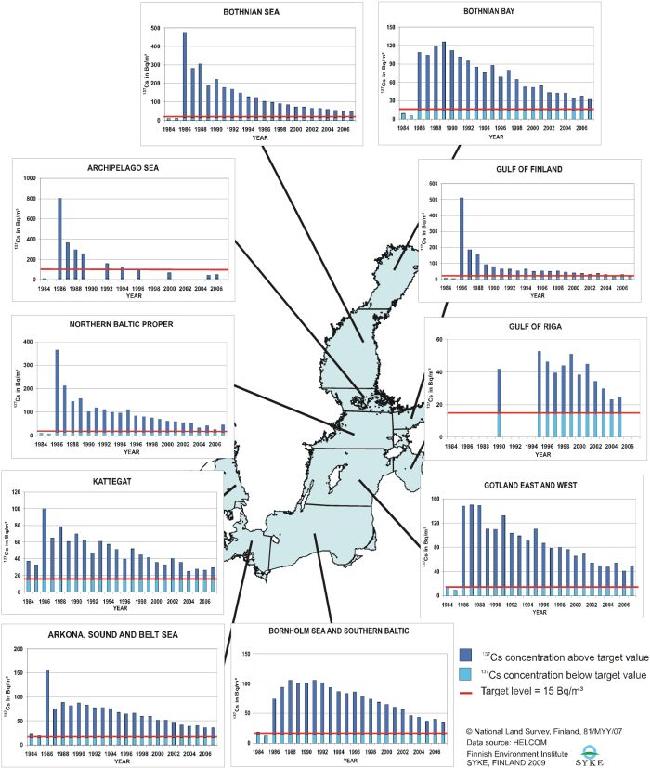Concentrations of the artificial radionuclide caesium-137 in Baltic Sea fish and surface waters
|
||||
Key message
The fallout from the Chernobyl accident in 1986 is the dominating source for Cs-137 in the Baltic Sea. The levels of Cs-137 in the Baltic Sea, both in water and biota, have shown declining trends since the early nineties.
Overall, the Cs-137 activity concentrations of herring and flounder muscle as well as of surface waters in the Baltic Sea basins are approaching the pre-Chernobyl levels (target value, see meta data).
Cs-137 is continuously transported from the Baltic Sea to the North Sea via Kattegat. Routine discharges of radioactivity from nuclear power plants into the Baltic Sea area are small and only detectable locally.
Results and assessment
The most significant source of artificial radioactivity in the Baltic Sea is the fallout from the Chernobyl accident. The direct total input of Cs-137 from Chernobyl to the Baltic Sea was estimated at 4700 TBq. Secondary riverine input from Chernobyl fallout added further 300 TBq of Cs-137.
Other important sources are global fallout from atmospheric nuclear weapons tests performed during the late 1950s and early 1960s and discharges from the nuclear reprocessing plants Sellafield and La Hague, located at the Irish Sea and The Channel. The latter sources have become of minor radiological importance, due to significant reduction of Cs-137 discharges from Sellafield in the past two decades.
The total collective dose from Cs-137 in the Baltic Sea is estimated at 2600 manSv of which about two thirds (1700 manSv) originate from Chernobyl fallout, about one quarter (650 manSv) from fallout from nuclear weapons testing, about 8% (200 manSv) from European reprocessing facilities, and about 0.04% (1 manSv) from nuclear installations bordering the Baltic Sea area.
Dose rates and doses from natural radioactivity dominate except for the year 1986 where the individual dose rates from Chernobyl fallout in some regions of the Baltic Sea approached that from natural radioactivity.
The maximum annual dose since 1950 to individuals from any critical group in the Baltic Sea area due to Cs-137 is estimated at 0.2 mSv y-1, which is below the dose limit of 1 mSv y-1 for the exposure of the general public set out in the EU Basic Safety Standards, 1996. It is unlikely that any individual has been exposed from marine pathways at a level above this dose limit considering the uncertainties involved in the assessment. Doses to man due to liquid discharges from nuclear power plants in the Baltic Sea area are estimated at or below the levels mentioned in the Basic Safety Standards to be of no regulatory concern (individual dose rate of 10 µSv y-1 and collective dose of 1 manSv). It should be noted that the assumptions made throughout the assessment were chosen to be realistic and not conservative. Consequently, this also applies to the estimated radiation doses to man.
Figure 1. 137Cs concentrations (in Bq/kg) in herring muscle in 1984-2007, as annual mean values by basin. Target values have been calculated as averages of pre-Chernobyl (1984-1985) concentrations. (Note: variable scales in the graphs). Click image to enlarge!
Figure 2. 137Cs concentrations (in Bq/kg) in plaice and flounder muscle in 1984-2007, as annual mean values by basin. Target values have been calculated as average of pre-Chernobyl (1984-1985) concentrations. Click image to enlarge!
Figure 3. 137Cs concentrations (in Bq/m3) in surface water (sampling depth <=10m) in 1984-2007, as annual mean values by basin. Target values have been calculated as average of pre-Chernobyl (1984-1985) concentrations. (Note: variable scales in the graphs). Click image to enlarge!
Meta data
1. Source:
Data have been collected by the Contracting Parties of HELCOM and submitted to the MORS (Monitoring of Radioactive Substances) database. The database is located in Finnish Environment Institute (SYKE).
2. Description of data: The data are based on 137Cs concentrations of a) herring (Clupea harengus L.), b) flounder (Platichthys flesus L.) and plaice (Pleuronectes platessa L.) and c) surface seawater (samples 0-10 m). Analyses have been made either from round fish (without head and entrails) or filets (herring), and for plaice and flounder from filets, only. Concentrations (Bq/kg) have been calculated from wet weight of the samples.Seawater concentrations (Bq/m3) have been analyzed from water sampled between 0-10 meters.
Data of each media (herring, plaice and flounder and sea water) have been averaged by basin and by year.
Average concentrations before the Chernobyl accident have been used as target values. These are:
| herring: | 2.5 Bq/kg |
| flounder and plaice: | 2.9 Bq/kg |
| seawater: | 15 Bq/m³ |
3. Spatial and temporal coverage: Herring data covers all the areas except Gulf of Riga and the area of Gotland East and West, as there are data only of 2003 and 2003-2007, respectively. There are no data on the Northern Baltic Proper in recent years (2003-2007). In the other areas, only a few years are missing.
Plaice and flounder data are very scarce both temporarily and spatially covering only four sea areas and several years missing. Sampling on plaice and flounder takes place only in some of the countries.
Sea water data coverage is almost complete, except the missing years in the Gulf of Riga and in the Archipelago Sea.
Further information
HELCOM (2009): Radioactivity in the Baltic Sea, 1999-2006 HELCOM thematic assessment. Balt. Sea Environ. Proc. No. 117: 60 pp.
HELCOM (2003): Radioactivity in the Baltic Sea 1992-1998. Balt. Sea Environ. Proc. No. 85: 102 pp.
HELCOM (1995): Radioactivity in the Baltic Sea 1984-1991. Balt. Sea Environ. Proc. No. 61: 182 pp.
HELCOM (1989): Three years observations of the levels of some radionuclides in the Baltic Sea after the Chernobyl Accident. Balt. Sea Environ. Proc. No. 31: 155 pp.
More detailed information on national monitoring results are available for Finland, Germany, Lithuania and Poland.
Further information
HELCOM (2009): Radioactivity in the Baltic Sea, 1999-2006 HELCOM thematic assessment. Balt. Sea Environ. Proc. No. 117: 60 pp.
HELCOM (2003): Radioactivity in the Baltic Sea 1992-1998. Balt. Sea Environ. Proc. No. 85: 102 pp.
HELCOM (1995): Radioactivity in the Baltic Sea 1984-1991. Balt. Sea Environ. Proc. No. 61: 182 pp.
HELCOM (1989): Three years observations of the levels of some radionuclides in the Baltic Sea after the Chernobyl Accident. Balt. Sea Environ. Proc. No. 31: 155 pp.
More detailed information on national monitoring results are available for Finland, Germany, Lithuania and Poland.For reference purposes, please cite this indicator fact sheet as follows:
[Author’s name(s)], [Year]. [Indicator Fact Sheet title]. HELCOM Indicator Fact Sheets 2009. Online. [Date Viewed], http://www.helcom.fi/environment2/ifs/en_GB/cover/.
Last updated: 16 November 2009




